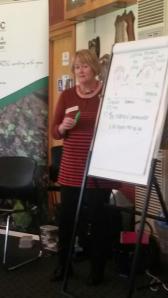A reminder of what not to do..
 Sometimes I need reminding by a group of participants about the “What not to do at the front of the room”. I recently attended a Australasia Pacific Extension Network (APEN) Roadshow – “Designing Effective Events … by understanding how adults learn” facilitated by Andrew Huffer. One of the discussion points was what are some of the things we dislike from presenters – the things we should take note of and change! There was nothing really new however some good reminders so we make all of our presentations “Wow”.
Sometimes I need reminding by a group of participants about the “What not to do at the front of the room”. I recently attended a Australasia Pacific Extension Network (APEN) Roadshow – “Designing Effective Events … by understanding how adults learn” facilitated by Andrew Huffer. One of the discussion points was what are some of the things we dislike from presenters – the things we should take note of and change! There was nothing really new however some good reminders so we make all of our presentations “Wow”.
Some of their key points raised
- Repetitious behaviour such as jiggling keys or coins in your pocket or swaying – something to be aware of when we are nervous. The key jiggling seems to be more common with males, because of pants with pockets containing the keys rather than handbags I suspect. Participants report finding this type of behaviour distracting.
- Reading from the power point presentation, demonstrating no awareness of the audience and not connecting with them. The power point should be there as a guide not be “the presentation” the audience is looking for a personal connection with the presenter. We learn and remember when we are emotionally connected with the presenter or the material in some way, think about how you can connect and do this very early in your presentation. for a few tips on power points https://workshopswithwow.com/tag/powerpoints/
- Not catering for various learning styles, perhaps the presenter is only considering his or her own learning style rather than being inclusive of all. I am a very visual learner and like to see colour and visuals as part of a presentation not just words and audio, others prefer activities. To review learning styles follow this link https://workshopswithwow.com/tag/vark/
- Too many acronyms, only those in the know know them! Avoid acronyms were possible or write them in full.
- Overload of too much complex data. Remember the famous quote “Everything should be made as simple as possible, but not simpler,” Albert Einstein. The complex data may be very meaningful to you, however, what are the key messages you need your audience to take away.
I’m sure my readers have many other “What’s not to do’s” and I would love you to add some comments to this blog. A big thank you to APEN and Andrew Huffer for making the workshops across the country a success.
After a slow time with my blog due to a busy workload and a trip overseas I am back on deck, you will be receiving more regular blogs once again. Thanks for your support and ongoing messages which keep me motivated.
